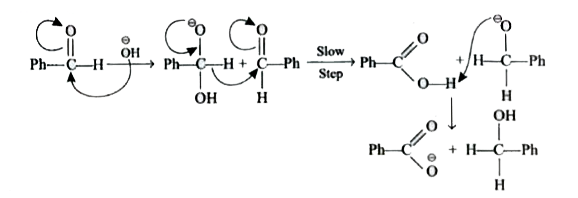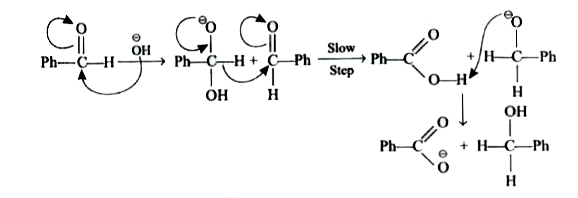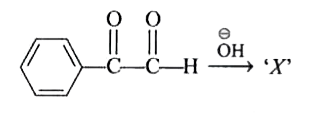The reaction is oxidation - reduction type and takes place in presence of 50% aqueous or ethanolic alkali One molecule of the aldehyde (missing of a- hydrogen atom )oxidizes, to corresponding carboxlic acid and the other is being reduced to the corresponding alcohol.

Mechanism : the mechanism involves two distinct steps Nucleophilic attack and hydride ion transfer.






The correct Answer is:(A)
Topper's Solved these Questions
- CARBONYL COMPOUNDSBOOK - NARAYNACHAPTER - CARBONYL COMPOUNDSEXERCISE - LEVEL -VI
99 Videos
- CARBONYL COMPOUNDSBOOK - NARAYNACHAPTER - CARBONYL COMPOUNDSEXERCISE - LEVEL -II (H.W)
20 Videos
- BENZENEBOOK - NARAYNACHAPTER - BENZENEEXERCISE - Level-6
121 Videos
- CHEMICAL BONDING AND MOLECULAR STRUCTUREBOOK - NARAYNACHAPTER - CHEMICAL BONDING AND MOLECULAR STRUCTUREEXERCISE - EXERCISE -4
54 Videos
Similar Questions
Aldehydes react with one equivalent of monohydric alcohol in the presence of dry hydrogen chloride to yield alkoxyalcohol intermediate , known as hemiacetals, which further react with one more molecule of alcohol to give a gem - dialkoxy compound known as acetal. Ketones react with ethtlene glycol under similar conditions to form cyclic products known as ethylene glycol ketals. Dry hydrogen chloride protonates the oxygen of the carbonyl compounds and therefore, increases the electrophilicity of the carbonyl carbon facilitating the nucleophilic attack of ethylene glycol. Acetals and ketals are hydrolysed with aqueous mineral acids to yield corresponding aldehydes and ketones respectively.
How can we recover the aldehydes and ketones from acetal and ketal ?
View SolutionAldehydes react with one equivalent of monohydric alcohol in the presence of dry hydrogen chloride to yield alkoxyalcohol intermediate , known as hemiacetals, which further react with one more molecule of alcohol to give a gem - dialkoxy compound known as acetal. Ketones react with ethtlene glycol under similar conditions to form cyclic products known as ethylene glycol ketals. Dry hydrogen chloride protonates the oxygen of the carbonyl compounds and therefore, increases the electrophilicity of the carbonyl carbon facilitating the nucleophilic attack of ethylene glycol. Acetals and ketals are hydrolysed with aqueous mineral acids to yield corresponding aldehydes and ketones respectively.
Give the reactions of fomation of alkoxyalcohol.
View Solution
Knowledge Check
Carbonyl compounds can serve both as reductant and oxidant, such processes being termed as disproportionation reactions. When non enolisable aldehydes are treated with strong aqueous or alcoholic base, one molecule of aldehydes undergoes reduction to alcohol while another molecule undergoes oxidation to acid. This disproportionation is the result of a nucleophilic addition of hydroxide ion to the aldehyde carbobyl to give a tetrahedral intermedate which can then regenerate the carbonyl group either by expelling hydroxide ion (to revert to aldehyde) or, by expelling hydride ions (to revert to carboxylic acid).
Above reaction isAproton-hydride transfer reactionBgiven by non enolizable aldehydesCthird order overall, first order in hydroxide and second order in aldehydeDfirst order in aldehyde and first order in hydroxide.Carbonyl compounds can serve both as reductant and oxidant, such processes being termed as disproportionation reactions. When non enolizable aldehydes are treated with strong aqueous or alcoholic base, one molecule of aldehydes undergoes reduction to alcohol while another molecule undergoes oxidation to acid. This disproportionation is the result of a nucleophilic addition of hydroxide ion to the aldehyde carbonyl to give a tetrahedral intermediate which can then regenerate the carbonyl group either by expelling hydroxide ion (to revert to aldehyde) or, by expelling hydride ions (to revert to carboxylic acid).
Above passage describesAAldol condensationBPerkin reactionCTishchenko reactionDCannizzaro's reaction.Carbonyl compounds can serve both as reductant and oxidant, such processes being termed as disproportionation reactions. When non enolisable aldehydes are treated with strong aqueous or alcoholic base, one molecule of aldehydes undergoes reduction to alcohol while another molecule undergoes oxidation to acid. This disproportionation is the result of a nucleophilic addition of hydroxide ion to the aldehyde carbonyl to give a tetrahedral intermediate which can then regenerate the carbonyl group either by expelling hydroxide ion (to revert to aldehyde) or, by expelling hydride ions (to revert to carboxylic acid).
The addition of hydroxide ion and expulsion of hydride ion is an example ofAnucleophilic addition-eliminationBelectrophilic addition-eliminationCnucleophilic additionDelectrphilic addition.
Oxidation and reduction always occur simultaneously. These reactions which involve simultaneous oxidation and reduction are called redox reactions. Therefore, every redox reaction is made up of two half reactions. One half reaction represents oxidation and other half reaction represents the reduction. Oxidation and reduction of an atom, molecule or ion can also be defined in terms of electrons. The substance that gains electrons, is reduced to a lower oxidation state and acts as an oxidising agent. Similarly, the substance which loses electrons is oxidised to a higher oxidation state, and is called a reducing agent.
In which of the following reactions hydrogen peroxide is acting as a reducing agent?
View SolutionOxidation and reduction always occur simultaneously. These reactions which involve simultaneous oxidation and reduction are called redox reactions. Therefore, every redox reaction is made up of two half reactions. One half reaction represents oxidation and other half reaction represents the reduction. Oxidation and reduction of an atom, molecule or ion can also be defined in terms of electrons. The substance that gains electrons, is reduced to a lower oxidation state and acts as an oxidising agent. Similarly, the substance which loses electrons is oxidised to a higher oxidation state, and is called a reducing agent.
In acidic medium, Mn7+ changes to Mn2+, it is
View SolutionOxidation and reduction always occur simultaneously. These reactions which involve simultaneous oxidation and reduction are called redox reactions. Therefore, every redox reaction is made up of two half reactions. One half reaction represents oxidation and other half reaction represents the reduction. Oxidation and reduction of an atom, molecule or ion can also be defined in terms of electrons. The substance that gains electrons, is reduced to a lower oxidation state and acts as an oxidising agent. Similarly, the substance which loses electrons is oxidised to a higher oxidation state, and is called a reducing agent.
The reaction : H2S+H2O2→S+2H2O indicates
View SolutionWhen an aldehyde with no α- hydrogen react with concentrated aqueous NaOH half the aldehyde is converted to carboxylic acid salt and other half is converted to an alcohol. In other words, half the reaction is oxidized and other half is reduced. This reaction is known as Cannizzaro reaction.

Mechanism:

Find out the products of following reaction:

X and Y are:
View SolutionWhen an aldehyde with no α- hydrogen react with concentrated aqueous NaOH half the aldehyde is converted to carboxylic acid salt and other half is converted to an alcohol. In other words, half the reaction is oxidized and other half is reduced. This reaction is known as Cannizzaro reaction.

Mechanism:

Find out X of the reaction:

View Solution

